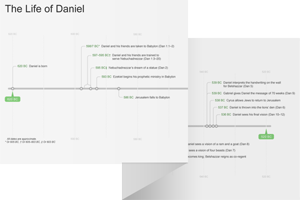10:1–21 Chapter 10 leads into the vision of ch. 11 and Dan 12; the three chapters compose one unit. This final revelation in chs. 10–12 is a further elaboration upon the visions of chs. 7–9 (see passage overview in 9:24–27). This chapter recounts Daniel’s encounter with an angelic figure. It describes his initial meeting and subsequent terror. The angel touches him and gives him strength before proceeding with the revelation, which is recounted in chs. 11–12. Much of the language and content of ch. 10 is borrowed or repeated from other parts of Daniel and the rest of the ot. |
10:1 the third year of Cyrus the king of the Persians 536 bc (see 1:21 and note).
a great tribulation Introduces that the main subject of Dan 10–12 is this conflict which will be described in chs. 11–12.
he understood the word The visions of chs. 7–9 may have prepared Daniel to understand the details of this vision.
10:2 I, Daniel, I myself Daniel narrates events in the first person (compare chs. 7–9).
was in mourning Daniel mourns in preparation for receiving a vision. For an extrabiblical example of this behavior, compare 4 Ezra 5:13; 6:35.
10:3 meat and wine The vegetarian diet initiated in Dan 1:8–16 apparently lasted only for a time. Daniel later ate meat and wine.
I did not use any ointment A typical indication of mourning.
the end of three whole weeks See v. 13.
10:4 twenty-fourth day of the first month Refers to the month of Nisan; Daniel was fasting through the Passover festival.
Daniel was fasting through the Passover festival.
 Israelite Calendar Table
Israelite Calendar Table
 Israelite Festivals Table
Israelite Festivals Table
the great river; that is, the Tigris Visionary experiences are often recounted in close proximity to water (see 8:2; Ezek 1:1; Rev 1:9, “island”).
(see 8:2; Ezek 1:1; Rev 1:9, “island”).
10:5 he was dressed in linen Typical clothing for angelic figures (see Dan 12:6–7; Ezek 9:2; 10:2).
for angelic figures (see Dan 12:6–7; Ezek 9:2; 10:2).
the gold of Although this is an unspecified angelic figure, the description echoes the glorified Christ in Rev 1:13.
10:6 his body was like Compare with the descriptions in Rev 1:14 and note, Rev 1:15 and note.
10:7 I saw, I, Daniel alone, the vision Reminiscent of Saul’s (Paul) experience on the road to Damascus (see Acts 9:3–7). Those who were with Daniel could not see what was taking place, but they fled out of terror.
10:8 no strength was left in me See Daniel 7:15.
my complexion grew deathly pale Daniel became pale from fear (see 5:6 and note).
10:9 I myself began falling into a trance on my face See 8:18; compare 7:15; Josh 5:14; Ezek 1:28; 3:23.
10:10 a hand touched me See note on Dan 8:18.
the words that I am speaking to you Refers to the content of chs. 11–12.
trembling A common response to a heavenly encounter throughout Daniel.
10:12 from the first day The beginning of the 21 days in v. 2, similar to the angelic visit in 9:23.
humble yourself before your God In contrast to the rulers in the book.
10:13 the prince of the kingdom of Persia The angelic custodian of Persia.
stood before me Indicates angelic warfare.
twenty-one days See Daniel 10:2.
Michael, one of the chief princes Possibly the patron angel of Israel. Michael is depicted as warring on behalf of Israel (see Rev 12:7) and is called Israel’s protector (Dan 12:1).
is depicted as warring on behalf of Israel (see Rev 12:7) and is called Israel’s protector (Dan 12:1).
10:14 the future See 8:17 and note.
10:16 one in the form of a human A common way to refer to angels in Daniel—they appear in human form. See 7:13 and note.
he touched my lips Reminiscent of Isa 6:7 and Jer 1:9.
anxieties Compare Isa 21:3.
10:17 how am I, a servant of my lord to speak Daniel is exhausted after this initial visionary experience.
10:18 he strengthened me The angel’s touch and words (Dan 10:19) strengthen Daniel.
10:19 You must not fear, O beloved man See vv. 11–12.
10:20 why I have come to you See v. 14.
And now I return The angel—probably Gabriel as in ch. 8 and Dan 9—must return to continue fighting. Before doing so, however, he must reveal to Daniel what will happen to his people at the end of days.
the prince of Javan will come After he finishes battling with the prince of Persia, the angel will have to battle with the prince of Greece. The sequence of Persia through Greece is reflected in the visions in Daniel (particularly ch. 8), including chs. 11–12. The angel battling with Greece’s patron angel is troubling for Israel.
10:21 the book of truth Not the books referenced in 7:10; 12:1. This book apparently contains the unfolding of history.
Michael, your prince The concept of Michael’s princeship originates with this reference. He occurs frequently in extrabiblical literature of the Hellenistic period and in the biblical corpus (vv. 13; 12:1; Jude 9; Rev 12:7).

|
About Faithlife Study BibleFaithlife Study Bible (FSB) is your guide to the ancient world of the Old and New Testaments, with study notes and articles that draw from a wide range of academic research. FSB helps you learn how to think about interpretation methods and issues so that you can gain a deeper understanding of the text. |
| Copyright |
Copyright 2012 Logos Bible Software. |
| Support Info | fsb |
 Loading…
Loading…

